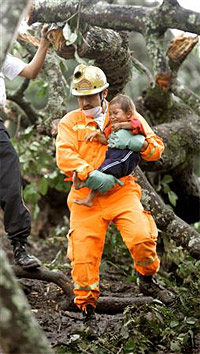 |
 |
 |
 News from Around the Americas | October 2005 News from Around the Americas | October 2005  
Guatemala May Declare Mudslide Mayan Mass Grave
 Frank Jack Daniel - Reuters Frank Jack Daniel - Reuters


| | A Guatemalan rescue worker carries a baby out of a mudslide affected zone in the Maya Indian village Panabaj, Guatemala. (Photo: Daniel Aguilar) |
Panabaj, Guatemala - A Guatemalan village buried under tons of dirt and debris may be declared a Mayan mass grave as rescuers give up digging for the remains of up to 1,400 people killed in a mudslide triggered by Hurricane Stan.

After days of heavy rain, mud, rocks and trees crashed down a volcano's slopes and into the Maya Indian village of Panabaj as people slept early on Wednesday, covering it in a quagmire up to 40 feet deep in places.

Some 1,400 people have disappeared and are dead according to the fire department, and a local official in charge of compiling death lists put the likely toll at about 1,000.

Foreign Minister Jorge Briz told Reuters the official toll was just over 500 dead but that was likely to at least double.

Rescuers dug for bodies in the stinking black mulch, choking on the smell of death. But they may have to abandon their search under a Guatemalan law that for health reasons puts a 72-hour limit on finding the dead.

Dozens of corpses have already been recovered and locals were drawing up names of the missing and dead, but with so many victims feared buried, authorities said they might abandon the search and declare the village a mass grave.

"We're more concerned with getting food to the people who are alive," said Ana Luisa Olmedo, a spokeswoman for Guatemala's civil protection agency.

MUD AND DEATH

Rescue workers stuffed herbs in their nostrils to block out the sickly odor of death. Others barked orders in the Mayan Tzutujil language as hundreds of men dug through the sludge with hoes, shovels and pick axes.

Behind a makeshift rope barrier, dozens of women dressed in the village's traditional purple blouses embroidered with birds and animals awaited news of missing kin.

Jose Tacaxoy, 28, sat in the mud near one of several trenches being dug in the quagmire, clutching a tattered photograph of his brother's wife with her three children.

"My brother is a salesman and was away when it happened, the rest are dead," he said choking back tears.

On a list he carried of 11 missing cousins was a cross through the name of the only one whose body had been found.

Digging for the dead is tragically common in Guatemala.

Forensic anthropologists are exhuming mass graves of some of the 200,000 victims of a 1960-1996 civil war, hoping to prove army responsibility for many of the killings.

The deaths in Panabaj may triple earlier estimates of the toll of fatalities from Hurricane Stan in the poor, Central American nation. The storm claimed another 67 lives in El Salvador, 20 in Mexico, 10 in Nicaragua and four in Honduras.

Large swathes of land in Central America and Mexico were flooded and dozens of mountain villages were hit by mudslides after days of downpours.

Relief came to some 300 inhabitants of Isla San Sebastian, a small island off the coast of southeastern El Salvador whose houses had been smashed by Stan's winds and rains, when boats came ashore loaded with United Nations World Food Program aid.

"It's tough dealing with things you don't expect," 64-year old Dionisio Chavarria said, waiting by an island shack with his nine children. "With the rain coming down and the sea churning at your side ... you put yourself in God's hands."

Additional reporting by Greg Brosnan in Mexico City and Alberto Barrera on Isla San Sebastian | 
 | |
 |



